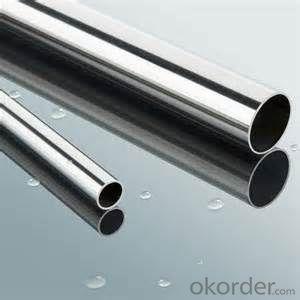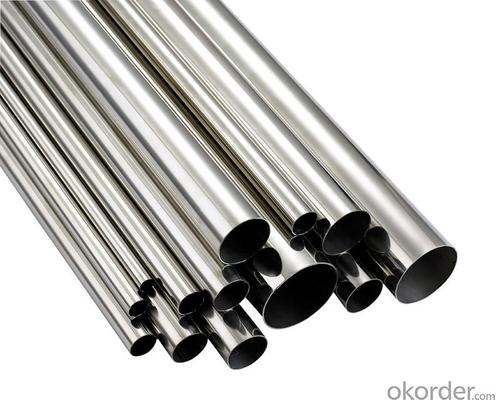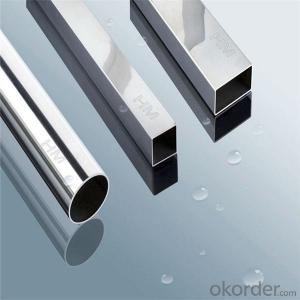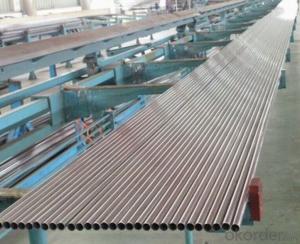STAINLESS STEEL PIPES 201 flower wave pipes
- Loading Port:
- China Main Port
- Payment Terms:
- TT OR LC
- Min Order Qty:
- -
- Supply Capability:
- -
OKorder Service Pledge
OKorder Financial Service
You Might Also Like
Description:
Stainless Steel Pipe
Material:
304 321 316 310
Packing:
In bundle
MOQ:
5 TONS
Comparison of standardized steels
| EN-standard Steel no. k.h.s DIN | EN-standard Steel name | SAE grade | UNS |
|---|---|---|---|
| 1.4109 | X65CrMo14 | 440A | S44002 |
| 1.4112 | X90CrMoV18 | 440B | S44003 |
| 1.4125 | X105CrMo17 | 440C | S44004 |
| | | 440F | S44020 |
| 1.4016 | X6Cr17 | 430 | S43000 |
| 1.4408 | G-X 6 CrNiMo 18-10 | 316 | |
| 1.4512 | X6CrTi12 | 409 | S40900 |
| | | 410 | S41000 |
| 1.4310 | X10CrNi18-8 | 301 | S30100 |
| 1.4318 | X2CrNiN18-7 | 301LN | |
| 1.4307 | X2CrNi18-9 | 304L | S30403 |
| 1.4306 | X2CrNi19-11 | 304L | S30403 |
| 1.4311 | X2CrNiN18-10 | 304LN | S30453 |
| 1.4301 | X5CrNi18-10 | 304 | S30400 |
| 1.4948 | X6CrNi18-11 | 304H | S30409 |
| 1.4303 | X5CrNi18-12 | 305 | S30500 |
| | X5CrNi30-9 | 312 | |
| 1.4541 | X6CrNiTi18-10 | 321 | S32100 |
| 1.4878 | X12CrNiTi18-9 | 321H | S32109 |
| 1.4404 | X2CrNiMo17-12-2 | 316L | S31603 |
| 1.4401 | X5CrNiMo17-12-2 | 316 | S31600 |
| 1.4406 | X2CrNiMoN17-12-2 | 316LN | S31653 |
| 1.4432 | X2CrNiMo17-12-3 | 316L | S31603 |
| 1.4435 | X2CrNiMo18-14-3 | 316L | S31603 |
| 1.4436 | X3CrNiMo17-13-3 | 316 | S31600 |
| 1.4571 | X6CrNiMoTi17-12-2 | 316Ti | S31635 |
| 1.4429 | X2CrNiMoN17-13-3 | 316LN | S31653 |
| 1.4438 | X2CrNiMo18-15-4 | 317L | S31703 |
| 1.4362 | X2CrNi23-4 | 2304 | S32304 |
| 1.4462 | X2CrNiMoN22-5-3 | 2205 | S31803/S32205 |
| 1.4539 | X1NiCrMoCu25-20-5 | 904L | N08904 |
| 1.4529 | X1NiCrMoCuN25-20-7 | | N08926 |
| 1.4547 | X1CrNiMoCuN20-18-7 | 254SMO | S31254 |
Stainless steel’s resistance to corrosion and staining, low maintenance and familiar lustre make it an ideal material for many applications. There are over 150 grades of stainless steel, of which fifteen are most commonly used. The alloy is milled into coils, sheets, plates, bars, wire, and tubing to be used in cookware, cutlery, household hardware, surgical instruments, major appliances, industrial equipment (for example, in sugar refineries) and as an automotive and aerospace structural alloy and construction material in large buildings. Storage tanks and tankers used to transport orange juice and other food are often made of stainless steel, because of its corrosion resistance. This also influences its use in commercial kitchens and food processing plants, as it can be steam-cleaned and sterilized and does not need paint or other surface finishes.
Stainless steel is used for jewelry and watches with 316L being the type commonly used for such applications. It can be re-finished by any jeweler and will not oxidize or turn black.
Some firearms incorporate stainless steel components as an alternative to blued or parkerized steel. Some handgun models, such as the Smith & Wesson Model 60 and the Colt M1911 pistol, can be made entirely from stainless steel. This gives a high-luster finish similar in appearance to nickel plating. Unlike plating, the finish is not subject to flaking, peeling, wear-off from rubbing (as when repeatedly removed from a holster), or rust when scratched.
- Q: Can stainless steel pipes be used for cryogenic applications?
- Yes, stainless steel pipes can be used for cryogenic applications. Stainless steel has excellent low temperature properties, such as good mechanical strength and resistance to embrittlement, making it suitable for handling cryogenic fluids and gases at extremely low temperatures.
- Q: What are the common sizes and dimensions of stainless steel pipes?
- Different applications and requirements necessitate a variety of sizes and dimensions for stainless steel pipes. The pipes' nominal pipe size (NPS), which denotes their inner diameter, is typically used to classify the common sizes and dimensions. Stainless steel pipes commonly come in sizes ranging from 1/8 inch to 36 inches in diameter. These sizes are widely used in industries like construction, oil and gas, chemical processing, and plumbing. However, it is also possible to have stainless steel pipes customized to meet specific needs. In terms of dimensions, stainless steel pipes usually adhere to standard schedules that specify their wall thickness. The most prevalent schedules are Schedule 5, Schedule 10, Schedule 40, and Schedule 80. Each schedule has a varying wall thickness, enabling different levels of pressure and strength. Furthermore, stainless steel pipes are available in various lengths, ranging from 20 feet to custom lengths based on the manufacturer and application. The standard length for stainless steel pipes is often 6 meters or 20 feet, but shorter or longer lengths can be requested or cut to fit specific project requirements. It is crucial to consider other factors when selecting stainless steel pipes, such as material grade, corrosion resistance, temperature and pressure ratings, and adherence to industry standards. To ensure the correct choice of stainless steel pipes for a specific application, it is advisable to consult with a professional or refer to the appropriate standards and specifications.
- Q: Are stainless steel pipes suitable for liquid storage tanks?
- Yes, stainless steel pipes are suitable for liquid storage tanks. Stainless steel has excellent corrosion resistance properties, making it ideal for storing various liquids, including water, chemicals, and food products. The material is highly resistant to rust, oxidation, and staining, ensuring that the stored liquids remain uncontaminated. Stainless steel pipes also have high strength and durability, allowing them to withstand the pressure and weight of the stored liquids. Additionally, stainless steel is easy to clean and maintain, making it a reliable choice for liquid storage applications.
- Q: Can stainless steel pipes be bent or shaped easily?
- Stainless steel pipes can be bent or shaped, but the ease of bending or shaping depends on various factors such as the thickness, diameter, and grade of the stainless steel. Generally, stainless steel pipes have a higher resistance to bending compared to other materials like copper or aluminum. However, with the use of specialized tools and techniques such as pipe benders or hydraulic presses, stainless steel pipes can be bent or shaped to desired angles or curves. It is important to note that excessive bending or shaping may cause the stainless steel pipe to weaken or distort, so it is crucial to follow proper procedures and guidelines to ensure the structural integrity of the pipe is maintained.
- Q: What is the difference between 321 and 316 stainless steel pipes?
- The main difference between 321 and 316 stainless steel pipes lies in their chemical composition and intended applications. 321 stainless steel pipes contain titanium, which stabilizes the material against chromium carbide formation. This makes it highly resistant to intergranular corrosion, even at elevated temperatures. As a result, 321 stainless steel pipes are commonly used in applications where high temperatures are involved, such as in the aerospace and power generation industries. On the other hand, 316 stainless steel pipes do not contain titanium but have molybdenum in their composition. This addition enhances the material's corrosion resistance, particularly in environments with chloride ions, making it suitable for applications in marine and coastal environments. Additionally, 316 stainless steel pipes are often used in the food and beverage industry due to their excellent resistance to acids and chemicals. In summary, while both 321 and 316 stainless steel pipes offer excellent corrosion resistance, the presence of titanium in 321 stainless steel pipes provides enhanced resistance to intergranular corrosion at high temperatures, whereas the addition of molybdenum in 316 stainless steel pipes improves their resistance to chloride-based corrosion in marine and coastal environments.
- Q: How do you determine the size of a stainless steel pipe?
- To determine the size of a stainless steel pipe, there are a few key factors to consider. Firstly, you need to measure the outside diameter (OD) of the pipe. This can be done using a caliper or a tape measure. Make sure to measure across the widest point of the pipe to get an accurate reading. Next, you should determine the wall thickness of the pipe. This can be measured using a caliper or a pipe gauge. The wall thickness is crucial in determining the strength and durability of the pipe. Once you have the OD and wall thickness measurements, you can proceed to calculate the nominal pipe size (NPS) or the trade size of the stainless steel pipe. This is typically denoted in inches and represents the inner diameter (ID) of the pipe. The NPS can be determined using industry standards or pipe size charts available online. It is important to note that stainless steel pipes are commonly available in a variety of schedules, which indicate the wall thickness. These schedules range from Schedule 5S (the thinnest) to Schedule XXS (the thickest). The schedule of the pipe should be considered while determining the size, as it affects the pipe's pressure rating and suitability for specific applications. In summary, determining the size of a stainless steel pipe involves measuring the outside diameter, determining the wall thickness, and calculating the nominal pipe size based on industry standards or pipe size charts.
- Q: Are stainless steel pipes more expensive than other materials?
- Stainless steel pipes are generally more expensive than other materials, but they offer significant advantages that justify their higher cost. Stainless steel pipes are known for their exceptional durability, corrosion resistance, and longevity. They can withstand extreme temperatures, harsh chemicals, and high pressure, making them suitable for a wide range of applications such as construction, plumbing, and industrial processes. Additionally, stainless steel pipes require minimal maintenance, reducing long-term costs. While the initial investment may be higher, the superior performance and extended lifespan of stainless steel pipes make them a worthwhile choice in many scenarios. Ultimately, the decision to choose stainless steel pipes should be based on the specific requirements and budget constraints of the project.
- Q: What is the difference between seamless and seamless annealed stainless steel pipes?
- The main difference between seamless and seamless annealed stainless steel pipes lies in their manufacturing process and the resulting properties of the pipes. Seamless stainless steel pipes are manufactured by piercing a hot billet or a solid bar to form a hollow cylindrical shape. This process eliminates the need for welding or any other joints, resulting in a uniform and continuous pipe with no seams. Seamless pipes are known for their excellent strength and ability to withstand high pressures, making them suitable for various applications in industries such as oil and gas, petrochemical, and construction. On the other hand, seamless annealed stainless steel pipes go through an additional heat treatment process called annealing. Annealing involves heating the pipe to a specific temperature, holding it at that temperature for a certain duration, and then cooling it slowly. This heat treatment helps to relieve internal stresses, reduce hardness, improve ductility, and enhance the overall mechanical properties of the stainless steel pipe. The annealing process also leads to the formation of a more homogenous microstructure, which further improves the corrosion resistance of the stainless steel. This makes seamless annealed stainless steel pipes particularly suitable for applications where excellent corrosion resistance is required, such as in the chemical processing, pharmaceutical, and food and beverage industries. In summary, while both seamless and seamless annealed stainless steel pipes are produced without any seams, the additional annealing process in the latter enhances its mechanical properties and corrosion resistance, making it more suitable for certain industries and applications.
- Q: Can stainless steel pipes be insulated with polyethylene naphthalate?
- No, stainless steel pipes cannot be insulated with polyethylene naphthalate.
- Q: Can stainless steel pipes be insulated with mineral wool?
- Yes, stainless steel pipes can indeed be insulated with mineral wool. Mineral wool is a common and effective insulation material used in various industries, including plumbing and construction. It is capable of withstanding high temperatures and offers excellent thermal and acoustic insulation properties. Additionally, mineral wool is non-combustible and resistant to moisture, making it suitable for insulating stainless steel pipes that carry hot or cold fluids. The insulation can help prevent heat loss, reduce energy consumption, and protect against condensation and pipe sweating.
Send your message to us
STAINLESS STEEL PIPES 201 flower wave pipes
- Loading Port:
- China Main Port
- Payment Terms:
- TT OR LC
- Min Order Qty:
- -
- Supply Capability:
- -
OKorder Service Pledge
OKorder Financial Service
Similar products
Hot products
Hot Searches
Related keywords






















